|
Knowing your dogs genetic
makeup
This section
will help you understand why knowing history will help in predicting litters
and how to identify what color genes your dog is definitely carrying.
It will also briefly explain the different genes in a scientific fashion
to help you apply them to your dog.
 How
does knowing my dogs history help me How
does knowing my dogs history help me
 Terms
used in coat color Terms
used in coat color
 What
are Loci and Alleles? What
are Loci and Alleles?
 How
do they apply to my dogs coat color? How
do they apply to my dogs coat color?
Heritage or History does not necessarily
give you all the answers and in some cases a color gene can be hidden for
many generations giving rise to some surprise litters. But the good news
is that from the surprise colors that may appear you will have more insight
to what the dog is really carrying. For example a chocolate dog bred to
another chocolate dog produces a blue puppy. You now know that both
parents carry a blue gene each even though they are chocolate. You also
know that at least one parent of the chocolate dog must have carried or
was the color blue and that the color blue is indeed in the lines.
The following is an
example of what two different colored dogs bred together can produce in
a litter.
You have a black and tan
mother who carries the genes blue and chocolate recessively.
She also carries a white gene that creates patches of white on the coat.
You can not see this gene because the (S) non white gene that she also
carries covers it over. Her genetic formula is (atatBbCCDdEESsp).
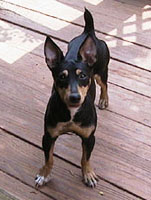 The father is black and
white (meaning he carries the black gene that contains no tan )and
carries
the genes blue and chocolate recessively. He also carries the gene
that makes a dog black white and tan along with white genes
that give a dog the piebald or patches of white. His genetic forumla is
(AatBbCCDdEEspsp)
The father is black and
white (meaning he carries the black gene that contains no tan )and
carries
the genes blue and chocolate recessively. He also carries the gene
that makes a dog black white and tan along with white genes
that give a dog the piebald or patches of white. His genetic forumla is
(AatBbCCDdEEspsp)
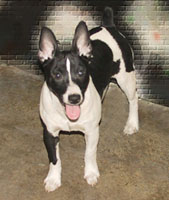 When the recessives genes
that you can not visibly see from both the mother and father combine, it
gives some of the offspring a double dose of the recessive genes. This
produces the colors chocolate and blue along with black. When the white
genes of both parents combine you get some pups without white or very little
on their coat and some with the piebald or patches of white pattern. Solid
colors of black, blue and chocolate come from the mothers (S) gene dominating
the fathers (sp) gene in some of the pups. What is important to remember
is that the white areas areas of the dog have nothing to do with the actual
base color of the dog. The white covers the base color as a pattern.
When the recessives genes
that you can not visibly see from both the mother and father combine, it
gives some of the offspring a double dose of the recessive genes. This
produces the colors chocolate and blue along with black. When the white
genes of both parents combine you get some pups without white or very little
on their coat and some with the piebald or patches of white pattern. Solid
colors of black, blue and chocolate come from the mothers (S) gene dominating
the fathers (sp) gene in some of the pups. What is important to remember
is that the white areas areas of the dog have nothing to do with the actual
base color of the dog. The white covers the base color as a pattern.
Some of the possible genetic combinations of
the offspring are as follows. According to Mendilian Law of Odds, if
the litter was large enough, all the color combinations shown below would
occur. Since most dogs do not have this many pups in one litter, you would
only see a selection. It is however possible to breed the same set of parents
again and come up with the colors that you did not see the first time.
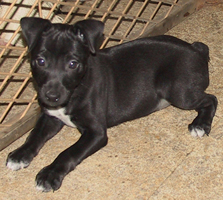
Solid Black
AatBBCCDDEESsp
|
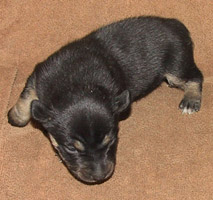
Black and Tan
atatBBCCDDEESsp
|
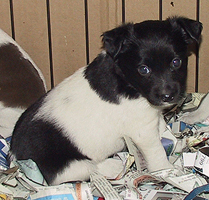
Black and White
AatBBCCDDEEspsp
|
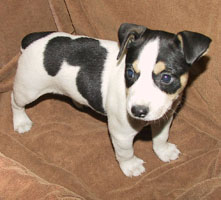
Black Tri
atatBBCCDDEEspsp
|
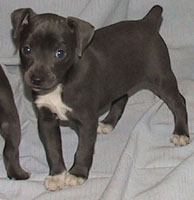
Solid Blue
AatBBCCddEESsp
|
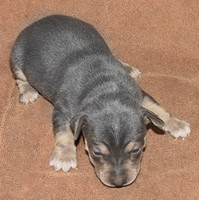
Blue and Tan
atatBBCCddEESsp
|
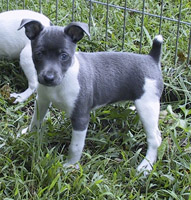
Blue and White
AatBBCCddEEspsp
|
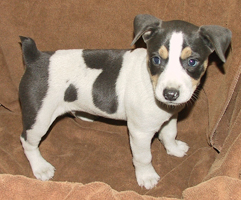 . .
Blue Tri
atatBBCCddEEspsp
|
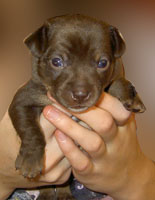
Solid Chocolate
AatbbCCDDEESsp
|
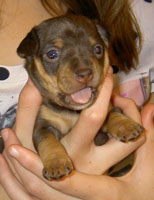
Chocolate and Tan
atatbbCCDDEESsp
|
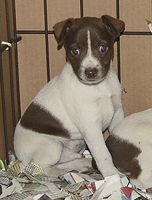
Chocolate and White
AatbbCCDDEEspsp
|
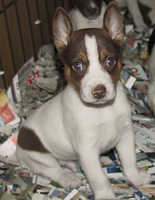
Chocolate Tri
atatbbCCDDEEspsp
|
This example just shows how important
it is to factor in recessive colors in order to make an accurate prediction.
Also note that even though the offspring shown above can also be carrying
recessives from the parents even though they are not visually expressing
the color. It is impossible to tell which one inherited what recessive
color unless they are bred and the color shows up.
TERMS:
It is wise to learn some
of the terms used in coat color to understand how the genes work together.
Definitions:
Genes -are hereditary units that determine
the makeup of the animal.
Loci- means a specific location of the
genes, in coat color there are 11. They are ABCDEGMPRST.
Alleles -are specific points on genes
that determine and influence various aspects of the animal such as coat
color and may have several alleles at a specific Locus each playing a different
role.
Homozygous -means that a dog carries two
alleles that are the same at a particular Loci.
Heterozygous- is when a dog carries two
alleles that are not the same at a specific Loci.
Phenotype- is what the dog's visual genetic
makeup appears to be.
Genotype- is what the true genetic makeup
of the dog is whether he visually shows them or not.
Dominant -produces the same phenotype
whether paired with an identical or dissimilar gene.
Recessive -genes can be hidden or masked
by a dominant gene.
Incomplete dominance -doesn't completely
hide or mask a recessive gene or one that is hypo static at a Loci and
still pushes through.
Epistatic - means that an allele at a
specific loci dominates other alleles at the same loci.
Hypostatic - means that an allele is recessive
to an allele at the same loci.
**************
INTRODUCTION TO LOCI AND ALLELES
The learning process
begins with the color genes (Loci and alleles) that a dog carries.
This section will explain the 11 Loci and the Alleles that fall
within them. It is nearly impossible to learn about an individual Loci
and its Alleles without discussing one or more along with it. They all
work in unison, very closely together dominating, fighting and pushing
to end up with the resultant colors.
Each gene does need to
be looked at individually to understand the action of it but it has specific
functions that are partly or solely dependent upon all the others. Unfortunately,
some things are not clear-cut when it comes to coat color inheritance.
There are many variables, but with a little studying of the genes and knowledge
of your dog's history, you can figure out exactly what they are carrying.
It just takes a little time and patience. Then you can plan your breeding
program with coat color in mind.
The following Loci and their alleles can
be applied to your dogs color. The Series is the specific Loci
and the genes found within them are the alleles. By looking at your
dog you will be able to identify some
of the genes that he is carrying. Note: the following descriptions are
based on true genetic formulas, not on a color which has been given a "name"
or is called a particular color within a breed.
(A Series) genes:
If your dog is black and white, blue and white,
chocolate (with a chocolate or red nose) or clear red and white, lemon
and white, or silver and white, without any tan markings or solid (meaning
no white or tan markings) in any of these colors, he carries the
(A) gene.
If your dog is tan and white, red/tan and white,
fawn and white, tan apricot and white, brindle and white, silver tan and
white, without tan point markings, or solid of these colors, your dog carries
the (ay) gene.
When he carries only the (at) gene your dog's
color will be black and tan, or Tri (example black, white and tan)
in any color. A dog that has the (at) gene always has tan markings provided
it is carried in a double dose. If your dog is sable, meaning tan with
black hairs running down its back, it carries the (ayat) gene. Blue fawn
is also a sable dog but also carries a dilute gene.
(B Series):
If your dog has a black nose, regardless of its
color, he carries the (B) gene. A dog that has a blue or slate colored
nose also carries the (B) gene even though the nose is not black. The nose
color is due to a different gene which turns it blue or slate.. If your
dog is any shade of chocolate or reddish in color with a chocolate nose
it carries the (b) gene. If your dog is Weimaraner Gray he also carries
the (b) gene along with (d) dilute blue.
(C Series):
When your dog's color stays relatively constant
through out life he carries the (C) gene. If your dog appears Crème
or Silver Fawn he may carry the (Cch) gene. The (Cch) gene considerably
lightens the color of tans and yellows to a crème to almost white
color starting soon after birth. If your dog is born dark and turns
white as he matures he may also be carrying the (Cch) gene. Most of the
other genes at the C loci are rather rare.
D Series):
If your dog is Black, Red Tan, Tan, Sable, Chocolate,
Brindle, Wheaten, Yorkie Blue, Lemon, Kerry Blue, Mustard, Pepper or Clear
Red, with or without white or tan markings, your dog carries the
(D) gene.
If your dog is Blue, Weimaraner Gray, Chocolate
Silver, Silver, Tan Apricot or Charcoal, with or without white or tan markings
he has the (d) gene and the coat always has the appearance of being flat
or dull in color.
If your dog is Weimaraner Gray/Pearl he also carries
the (b) chocolate. An Apricot dog may carry either a (D) or (d) and seems
to be a breed specific color.
(E Series):
If your dog has a black mask he carries the (Em)
gene. Dogs that are Blacks, Blues, Tans, Chocolates, Silver, Charcoals,
Merle, Sable, Kerry Blue, Mustard, Pepper or Yorkie Blue with or without
white or tan markings carry the (E) gene.
A dog that carries the (ebr) gene is Brindle
(Tiger striped pattern). A brindle pattern shows up best when the base
color of the dog is tan or sable.
If your dog is Lemon, Clear Red, Wheaten, Creme,
or Apricot it carries the (e) gene. You will not see any black or
dark hairs on the dog's coat that has the (e) gene.
(G Series): (G) dominate graying,
and (g) non-graying. As the dog grows older, a very distinct graying pattern
starts to show up on the dog's coat. Much like the way humans start to
gray. It will progress until the coat has become altogether gray. When
the dog carries the (g) recessive, non-graying gene, the coat color will
not turn gray. It is a straightforward gene in that either it is present
or itís not and will be very obvious to the eye. It needs to only
be present in single dose in order for it to visibly show. This gene is
not to be confused with natural gray hairs that may form, typically around
the dog's face, at a much later stage in life. Dog breeds that typically
carry this gene are the Bedlington, Kerry Blue Terriers and Poodles.
(M Series):(M) is dominant
merle and is visibly seen whether it is in a Homozygous or Heterozygous
state. It also frequently produces blue, green, gold and brown eyes that
can be seen in any combination. Merle is a dangerous gene when seen as
a double dose. It can produce deafness, blindness and birth defects. Two
dogs with a double dose of merle should never be bred together for obvious
reasons. Exquisite patterns of black, gray, white and tan are seen in endless
combinations and patterns all over the dog's coat. There can be large patches
or uneven mottling, more or less white or none at all.
When the Merle gene is in combination with
an (A) or (at) gene the most striking patterns appear. The darker colors
show more patterns. While seen with the (ay) tan gene the effect is lessened
or not seen at all. It is usually visible at birth and seen as darker or
lighter red or tan areas but can sometimes also bring up almost black areas.
It fades as the puppy grows older. When it is mixed with (ebr) brindle,
the patterns are not only patched, mottled and broken up but also striped.
If the dog also carries a double (b) chocolate allele the colors are also
very striking except they are in hues of browns instead of blacks. When
the Merle gene combines in dominant double dose (MM), that is the Homozygous
state, it can be lethal or cause blindness in the offspring.
(m) is the non-merle gene and does not effect the coat in anyway.
(R Series):
Roaning and ticking probably run
hand in hand with one another. It can be extremely hard to confidently
distinguish between a ticked dog and a Roaned dog. The only thing that
can be said confidently about the Roan gene is that if it is present in
dominant form it will show visibly on the dog's coat.
(S Series):
If your dog is any solid color or black and tan,
or Tan pointed in any color (without any white color) on the coat he carries
the (S) gene.
When white markings only appear in any or all
of the following areas: chest, collar, blaze, boots or toes and tip of
tail, the dog carries the (si) gene. The (si) gene does not appear as patches
of white and will not cut up the legs to the back of the dog. It is commonly
called Tuxedo or Irish Spotting.
The (sp) gene produces patches of color or blankets
of color on the dog's coat and is commonly called Piebald.
A dog with the (sw) gene will be solid white or
may have color only on its head or base of tail. Sometimes called Extreme
White. For more info.
(T Series):
A dog that has "freckles" on its coat or skin
carries the (T) gene called Ticking. They may not appear at birth
but slowly start to appear as the dog gets older. It can appear as a large
amount almost covering the dog or very little appearing only in certain
areas. A dog that does not have ticking carries the (t) gene. For
more info.
In a nutshell
Each gene needs to be looked at individually
and studied as to how it works when in combination with other genes.
Each gene has a specific function but is partly
or solely dependent upon all the others.
The most dominant gene is shown in capital
letters.
A
ay
As
at
aw
|
B
b
|
C
cch
ce
|
D
d
|
Em
Ebr
E
e
|
G
g
|
M
m
|
R
r
|
S
si
sp
sw
|
T
t
|
The A Series determines the base color that
the dog will be.
(A)=black (aw)=agouti or wild
color (ay)=tan-sable (As)= Saddle back/Calico
(at)=black and tan
.
The B Series will change black to brown.
(B)=black pigment (b)=chocolate pigment
on the coat and will also change the color of the dogs nose to brown when
in a homozygous
state (double dose). Please note that chocolate
is not a dilute gene.
The C Series causes full depth of color
to form or will lighten the color.
(C )=full depth of color to form (Cch)=effects
tan-sable pigment the most changing it to a much lighter shade. It has
little or no influence on dark pigment. (Ce)=recessive white can change
a dogs coat to all white (this gene is theorized to be rather rare).
The D Series is the gene of dilution.
(D)=retains full depth of color and intensity
(d)=reduces black to a gray color or chocolate pigment diluting it to Pearl/Weimerainer
Grey.
It can also change a black nose to blue, mauve,
self or slate.
The E Series extends or restricts pigment
from forming.
(Em)= allows a black mask to form (Ebr)=
brindle patterning (E)=full pigment without the mask (e)=restricts
black pigment from forming changing the color to red, orange or yellow.
ie: a black dog will become lemon, apricot or clear red. It will only slightly
lighten the color when a dog is tan or chocolate.
The S Series keeps white color out of the
coat, adds it in specific patterns or turns the dog completely white.
(S)= does not allow any white pigment to form on
the dogs coat. An exception would be a spot of white on the chest or toe
(si)= commonly called Irish Spotting or Tuxedo forming a white collar,
blaze, boots, on the tip of tail, and chest area. This pattern can show
up in all of these areas or just some to varying degrees. (sp)= patches
of white color forms all over the dogs body or just in areas. (sw)= extreme
white causing the dog to turn completely white or nearly white. |



